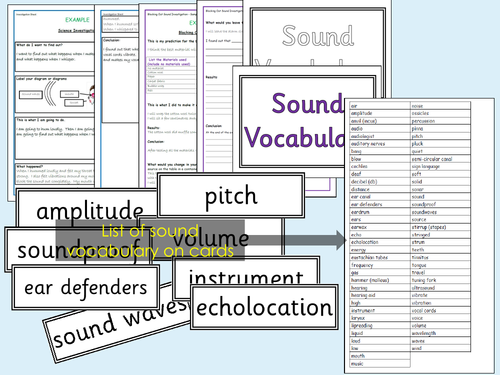







39 Slide PowerPoint Presentation on sound and the practical tasks children can undertake.
The Teacher’s Note sets out how you can introduce the topic and suggestions on how to organize the activities and list resources needed.
You can organize a carousel system (different workstations) - so each table deals with a different aspect on sound or you can do a whole class lesson on one aspect of sound week by week, ending the term on a sound carousel for assessment.
The resource comprises:
- PowerPoint Presentation – Review Work on sounds and contains background information on how the piano, guitar and wind instruments work and how we hear.
- Teacher’s Notes (3 pages, excluding credit page)
- 14 Activity Cards (You can laminate for durability), cut out for each table. The cards contain questions to prompt the children to carry out their tasks.
- There are ready-made investigations sheets and sample investigations sheets.
- Numbered Table cards
- Vocabulary cards (See preview pane)
- Worksheet on How We Hear
- Worksheet on Volume and Pitch
Experiments:
-
Vibration involving moving objects- e.g. children can experiment with a tuning forks and water and ping-pong balls, rice on drums.
-
Sound and Pitch - e.g. use empty bottles filled with different levels of liquid to produce different pitches and also blow horizontally along the edge to produce sounds similar to wind instruments; and/or experiment with guitar strings –shortening and lengthening the string to produce different sounds;
-
Listening devices - experiment with different string telephones by changing variables such as type of string and material of cups;
-
Blocking Out Sound activities- Children can make ear defenders out of margarine tubs packed with different materials or they can wrap the sound source like a buzzer or alarm clock with different materials to see which is best at muffling the sound.
-
Optional - Musical Instruments - Children can make musical instruments or use the ones they may have made in previous lessons - to adjust how they use it or even make it better - can experiment with various aspects of sound.
-
Outside activity - How sound gets fainter as you travel further away - Use a sound source like a buzzer.
There are instructions to make a simple balloon drum, a packing tape drum, comb kazoo and a guitar.
US Version Available.
Goes well with:
https://www.tes.com/teaching-resource/sounds-how-humans-and-animals-hear-musical-instruments-our-voice-plans-presentations-activities-11242250
Something went wrong, please try again later.
This resource hasn't been reviewed yet
To ensure quality for our reviews, only customers who have purchased this resource can review it
Report this resourceto let us know if it violates our terms and conditions.
Our customer service team will review your report and will be in touch.